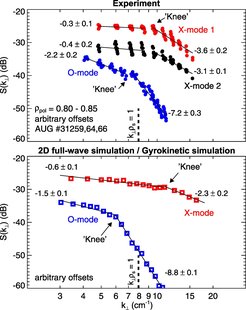Breakthrough in the understanding of wavenumber spectra measured by Doppler reflectometry
Fluctuation wavenumber spectra contain a variety of information about underlying microinstabilities and energy transfer mechanisms
The wavenumber spectrum of a magnetic confinement fusion experiment has many degrees of freedom, and it is a very challenging (and potentially very rewarding) task to validate gyrokinetic turbulence simulations through wavenumber spectra. Nowadays, the prevailing diagnostic to measure local density fluctuation wavenumber spectra is Doppler reflectometry. However, it has been pointed out by theory that the validity of turbulence amplitude measurements could be affected by the microwave polarization. In particular, theory predicts that nonlinear effects are encountered for extraordinary mode (X-mode) polarization at lower turbulence levels than for ordinary mode (O-mode) polarization. Since the diagnostic response can be linear, nonlinear, or even saturated, it is indispensable to use a reliable synthetic diagnostic for validation studies.

A multi-year effort with contributions from five different institutes in Germany, France and the USA has now yielded conclusive results by combining X- and O-mode wave polarizations in the same antenna, thus measuring at the same radial, poloidal and toroidal location in the plasma. The measured wavenumber spectra show pronounced differences (see figure), which indicates that a diagnostic effect must be responsible. Accompanying gyrokinetic simulations have been used to simulate the corresponding plasma turbulence. The latter has then been used as input for two-dimensional full-wave simulations, which were performed in X- and O-mode polarizations. The wavenumber spectra resulting from the simulation are strikingly comparable to the experimental ones (see figure). Comparison with theory confirms that the X-mode measurements have been obtained in the nonlinear and saturation regimes, while the O-mode measurements were in the linear regime. These results show first, that synthetic diagnostics are indispensable if non-trivial diagnostics are used and quantitative statements are made and second, that wavenumber spectra obtained by Doppler reflectometry should be regarded with care if it is to be expected that they have been obtained in the non-linear or saturated probing regime, which is more probable in X-mode Doppler reflectometry. This work has now appeared in two journal articles.
J. R. Pinzón et al., Plasma Phys. Control. Fusion 59, 035005 (2017)
dx.doi.org/10.1088/1361-6587/aa543c
T. Happel et al., Plasma Phys. Control. Fusion 59, 054009 (2017)
dx.doi.org/10.1088/1361-6587/aa645b
